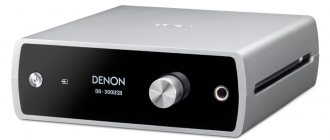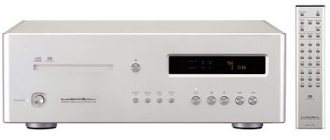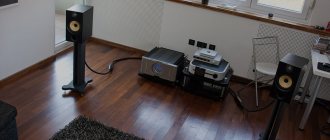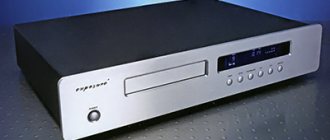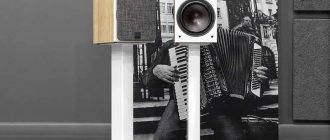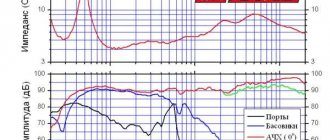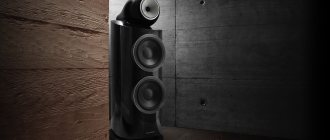Hegel HD20
The Afordable High End class components also include a converter developed in Norway. There are three of them in the Hegel line, and the HD20 model occupies the top position. The device is notable for its design - the compact body is made of metal with a significant margin of safety. On the front panel there is only a corporate logo and a display - all switching is carried out from a miniature card-type remote control.
On the rear panel there is a block for a standard power cable, a power supply switch and a set of inputs and outputs. The first are represented by a USB socket (type B), optical TOSLink and a pair of coaxial cables. The second - a linear stereo pair on RCA and balanced XLR. The HD20 does not have alternative digital interfaces, including wireless ones.
The digital path is built on a 24-bit chip, which also implements a digital volume control. The converter accepts data via USB at sampling rates up to 96 kHz, and via the SP/DIF protocol - up to 192 kHz, and a proprietary impedance matching system is used at the Coax 1 input to reduce jitter. The analogue section is also tricky. It has a bandwidth from 0 (!) to 50,000 Hz. Distortion does not exceed seventy-thousandths of a percent, and the noise level is simply on the verge of possible - 140 dB! The fact that the analog filter also has a linear phase characteristic, and the output voltage is increased from the standard 2 to 2.5 V, is not even surprising. The converter's filling is powered by an internal system, which is more likely typical of some kind of integrated circuit - with a massive toroidal transformer and a 30,000 µF buffer.
Do you know the feeling when, when playing back, everything begins to seem much more weighty, clear and significant than usual? The Hegel HD20 gives the same effect of a large system. The infra-low component is monumental. The bass is massive but fast, with exemplary and dynamic attack. The middle register captivates with its transparency, detail and purity. The top is only a little sharp, but such a radiantly ringing character of the treble transmission even suits the musical interpretation offered by the Norwegian transducer. He seems to be typing every sound. In the scene, every image is a monument. The physicality is simply extraordinary.
However, super-distinction, including spatial clarity, is still tiring. An hour of listening flies by in one breath, and then you begin to notice that there is little plasticity in the bass aftertones. In the middle register there is a slight lack of animation and tenderness - especially in the rendering of fine details. Everything is said above about upper case.
Maybe when switching to USB, Hegel will show some euphony? This is true, but only partly. The middle is rendered a little smoother. The nature of the reproduction of higher frequencies changes - more air, less dynamic tension. But at the same time, the microdynamic pattern also becomes a little poorer on the trebles. The sound becomes simpler, while the HD20 fully retains its signature power qualities in the low register. The result can be described as follows: a bit rough, but extremely intelligible.
In the scene, every image is a monument. The physicality is simply extraordinary
- Manufacturer Hegel (Norway)
- Made in China
- Digital inputs USB, TOSLink, 2 Coax
- No digital outputs
- Analog Outputs Linear RCA and Balanced XLR
- No wireless interface
- Reproducible range, Hz 0 - 50,000
- With unevenness, dB n.d.
- Distortion, % 0.001
- Dynamic range, dB n.d.
- Signal-to-noise ratio, dB more than 140
- Dimensions, mm 210 x 50 x 260
- Weight, kg 3.5
- price, rub. 59000
- www.hegel.com
PLEASED
Unusual dynamics in the low register. The mids are quite detailed and transparent. The upper register is well developed at both the macro and microdynamic levels. Very physical scene.
DISAPPOINTED
Bass after-sounds are somewhat lacking in plasticity of reproduction, and details in the middle register lack precision and delicacy. Via USB it sounds “cheaper” than via SP/DIF.
USB DACs | Quad Link D-1 | Arcam rDAC Wireless | Rega DAC | NAD M51 |Hegel HD20 | Blacknote DAC30 | Chord QBD76HD
share
Tags: Hegel
The lineup
Complete amplifiers
The Hegel complete amplifier range includes 2 models with SoundEngine technology: H80 and H300. The flagship H300 is equipped with a powerful toroidal transformer, AK4399 DAC, has a dual mono topology and develops 250 W per channel (8 ohms).
Complete amplifier Hegel H300
Hand-selected pairs of FET transistors are installed to reduce high-order distortion. There is a wide choice of digital and analog connectors - USB port (24 bit/96 kHz) and coaxial output. The damping coefficient exceeds 1000 units, and the SOI is only 0.005%. It is also worth noting that the H300 has a “pass-through input” for connecting the front channels of an AV receiver.
Hegel H80 Complete Amplifier
The H80 amplifier has lower power (2 x 75 W, 8 Ohms).
Preamplifiers
The series consists of models P20 and P30. The input selector and precision volume attenuator are symmetrically located on their slightly convex aluminum panels. The large power button is located in the center of the facade.
Preamplifier Hegel P20
The preamplifiers feature select components and a range of balanced and unbalanced inputs/outputs, including a loop-through input. Harmonic distortion: 0.005%. The P20 uses low-noise silicon-germanium transistors. The older model P30 is equipped with SoundEngine technology, has a shortened signal path and uses complementary pairs of FET transistors.
Power amplifiers
Range of terminals: H30, H4SE and H20. The top-end 45-kilogram H30 monoblock produces more than 1 kW of power (8 ohms), is equipped with JFET and MOSFET transistors in the input section (to eliminate higher-order harmonics), and uses an updated version of SoundEngine. The monoblock has 3 XLR and RCA connectors and can work as a stereo amplifier. The sound of the H30 impresses not only with dynamics, attack and deep bass, but also with detail, and even with a pleasant “tube” tint. The power supply contains a pair of toroidal transformers, and the output contains 56 low-noise bipolar transistors.
Power amplifier Hegel H4SE
The H4SE delivers 300 watts per channel (8 ohms) and uses Next-Gen technology (selected input FETs) for smooth, clear, and rhythmic sound. The voltage and current amplification stages in each individual channel are separated (DualAmp technology). The topology is “dual mono”. The powerhouse received RCA, XLR inputs and 4 pairs of terminals.
The H20 end (2 x 200 W, 8 Ohm) has improved FET technology and uses proprietary SoundEngine modules.
External DACs
DAC series: HD11, HD20 and HD25. The flagship HD25 is equipped with an Asahi Kasei Microsystems AK4399EQ chip (32 bit/192 kHz), a display, an asynchronous USB port (24 bit/192 kHz), a volume control (100 steps, via remote control) for direct connection to a power amplifier, a clock generator with a special technology to eliminate jitter and two digital filters.
Top DAC Hegel HD25
The full range of digital inputs are impedance matched and galvanically isolated to reduce distortion. You can select a source from the remote control or by touching the touch front panel.
Hegel HD25 DAC patch panel
There is a toroidal transformer with a buffer of 30,000 uF and a high-quality element base with silicon-germanium transistors in the analog circuit. The SOI is negligible (0.0006%). Outputs: XLR and RCA. The HD20 model received a different converter (24 bit/192 kHz) and a USB port (24 bit/96 kHz). The younger HD11 has a 32-bit converter chip and does not have a display.
CD players
The Hegel program contains two CD players - the top-end CDP4A and the CDP2A MK2. The flagship CDP4A is assembled in an anti-vibration case with two large control keys and a display on the front, and is equipped with a Philips drive.
CD player Hegel CDP4A
In addition to balanced and regular outputs, there is a digital coaxial. The model differs from the CDP2A MK2 in an improved circuit topology, a different DAC (CS4397, 24 bit/352 kHz) with a synchronous sampling frequency converter, an improved power supply, a PMD100 filter and higher-class components. SuperClock 2 clock generator with low jitter (10 ps) is used.
Under the cover of the Hegel CDP4A CD player
SUPER
Hegel also produces a mini headphone amplifier SUPER, which uses technologies similar to SoundEngine, which allows you to pump up the tightest headphones.
Compact DAC Hegel SUPER
The model is made in an aluminum case and is equipped with a built-in DAC on the Micro-USB connector (24 bit/96 kHz). At the output, the mini-jack is combined with an optical connector. Output impedance: 1 Ohm. The Hegel brand also produces two universal Xtras remote controls – the flat plastic RC3 and the aluminum RC2.
“Big Brother” Hegel: the story of one amplifier
Anders Ertzaid,
Commercial Director, Hegel Music Systems
tells the story of the creation of the new flagship of the Norwegian company - the Hegel H590 integrated amplifier
In the spring of 2022 we started working on a project that would turn into a very good power amplifier. No, not just good. We thought it had to be outstanding.
To achieve this, we have reworked our classic amplification circuit and implemented new ideas. We needed to come up with something new to beat our own reference H30 all-in-one PCs. There were other reasons - for example, the fact that the H30 used discontinued Toshiba transistors.
Until now, most of Hegel's high-end products have been based on the design of the H4 power amplifier and, in part, the H200 integrated amplifier. Two products that allowed Hegel to take a big step forward in their time. And at the same time – iconic models of the company. Naturally, the design was improved, new technologies were used - such as SoundEngine 2, and others. But many ideas remained unchanged.
By the way, a similar situation developed with our DACs, the topology of which is fundamentally based on the HD10 circuit (another iconic product!). And so it was until the release of the Mohican CD player. But more on that later.
Back on topic: we didn't want to change what was already good about our analog design. But we wanted to use our latest developments and find solutions that will take sound quality to a new level.
We spent a month on a prototype, codenamed “big brother.”
We measured, refined, and listened. This was a very important project for us and I was afraid that I would start wishful thinking. It’s very difficult when you don’t compare with something standard, but try to create this very standard. So I invited two people who were not associated with the company, but who could be trusted - their opinion was important to me. Johan and Knut have good hearing, and they also tell the truth. Thanks to both of them!
The amplifier began to take shape and it turned out frighteningly good. Then we asked ourselves the question: “Who REALLY needs a rack of pre/power/DAC/streamer when you can get it all in one case?”
Our founder Bent and chief software engineer Joakim were able to further improve what we learned while developing Mohican. The amazing sound of "Mohican" is mainly based on the unique DAC, which is very different from what we have done before.
Almost overnight, the “big brother” project went from a reference power amplifier to an integrated amplifier.
After a few months:
- “Did you notice, Anders? On a different system and older prototypes of this project, we simply switched between tracks. Two minutes each, etc. But now... both sat and listened to all 8 minutes or so of Hungarian Raspsody No. 2. And they didn’t stop thinking!”
...That's what Johan said one day at the beginning of 2022. And I still haven't found a better way to describe the H590 we were listening to back then. The same H590 that you can now listen to for yourself. This reminded me of an old advertisement for Infinity IRS Beta speakers - “turn off the lights, turn on your favorite music and you will listen to it until the morning.”
H590 was born. And it turned out phenomenal.
WHAT
Amplifier…
301 watts per channel? Why? “Well, that’s more than 300!” Bent would have said with a laugh. But this is not just a joke: the power of 301 W is indicated because the watts there really are more than 300. And because the amplifier is much more powerful than the H360 (250 W/channel).
I think the picture speaks for itself. The radiator on top is from H590. Below - from H360. Compared to the H360, the H590 has a 50% larger power supply, and 12 output transistors versus 8 on each channel.
Another improvement we received during the development of the H190: updated pre-stage transistors, which were now used in the H590.
SoundEngine 2
SoundEngine 2 technology was originally developed for the H360 and was later used in all integrated amplifiers. SE 2 is much faster and reduces dynamic distortion 75% better than SE 1. This technology is especially effective at the zero crossing point.
Another improvement to the SE 2 is a higher damping factor, resulting in a more stable amplifier. This factor is very important for bass control.
The H590 uses the latest version of SE 2 and features a damping factor of 4000.
Magnetic interference
Among the unique improvements used in the design of the H590 is the elimination of magnetic interference in the case. We removed steel components from the sides and top/bottom of the case.
The DAC and preamp sections are specially shielded to eliminate interference from the large toroidal transformer.
These changes gave us the opportunity to improve the dynamic range of the H590.
Digital-to-analog converter
As mentioned, the H590 DAC is largely based on ideas gained during the development of the Mohican. It is at least no worse (and in some ways, perhaps better) than the HD30.
The main feature of the DAC in the H590 is that all sampling frequencies are processed in its original form. No frequency change.
The new DAC allowed the Hegel H590 to take part in a live concert at Wisseloord Studios.
This solution was used for the first time at Mohican. And this is the main reason why it sounds so much better than the HD30 on 16/44 footage.
Special UPnP…
“Here, try it,” software developer Joakim once grinned. He brought a small microcircuit. “Turn on some 16/44 UPnP content and just listen.”
I tried. And I was shocked! Exactly what Joaquim did is still a mystery, but streaming a PCM 16 / 44 stream over UPnP on the H590 is pure magic!
New USB
Our new engineer Oyvind was responsible for creating a completely new USB interface for the H590. The main goal was to get the best sound. The second is support for MQA and other high-resolution formats such as DSD256 or PCM 23/384.
And besides, we wanted to get a universal USB platform with minimal requirements for driver installation.
MQA
People talk about MQA. Is he better? Worse? Is this a compressed format? Or with the original master recording?
We decided that we would not bother with all this. MQA makes it easier to distribute high-resolution audio files. What can make us refuse to use it? We're very impressed with the H590's MQA playback capabilities. USB playback is supported and MQA has its own path that never interferes with PCM.
Streaming
Many of you probably know that even AirPlay in Hegel amplifiers sounds better than the implementations of other companies. We created our own version and it is certified by Apple.
The H590's streaming platform is the same as the H190's, meaning it's more versatile and easier to use than other Hegel amplifiers. Additionally, we may add new functionality (such as Spotify Connect) via firmware update.
WHY?
Why H590?
At Hegel we never look at what others are doing. We do not focus on their products, we do not compare sound and functions. It really doesn't matter to us.
We are interested in our own users. Big words, I know. But we think the future of High End and Hi-Fi depends on manufacturers looking to their customers. And not against competitors. So we regularly host P&D (Pizza and Development) parties.
About three times a year, everyone in the company gets together after work to discuss predictions about how people will use music in the future, and where we might fit into that future. What devices can we make to meet requests, etc. Or we simply discuss those things that we want to use ourselves.
The decision to change the power amplifier to the H590 integrated unit was the finale of just such a party. Very late. We decided that people want simplicity, especially if they can get it without sacrificing quality. The H590 is a good step in this direction. A VERY complete amplifier that can be used by people of all ages.
It has many smart features and outstanding sound.
Summary
At Hegel we do everything to achieve the highest possible sound quality. From the very first Hegel device (pictured) to the most modern.
Sound quality is always at the forefront. Functions are added later, and only when they do not affect the sound quality. This is how it has always been and this is how it will always be.
We may not always be the most fashionable, but we should always be the best.
COMPARISON
We have compiled a special comparison table for the current range of Hegel integrated amplifiers.
Go to the manufacturer's catalog
